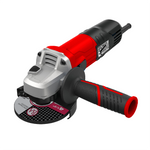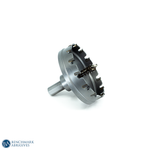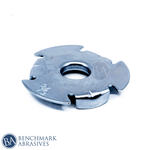
How to Choose the Best Sandpaper for Wood: Grit and Grain Explained

The abrasive grain and the grit size are crucial when choosing the best sandpaper for wood. The correct combination of grain and grit, custom to the particular wood species and the project stage, is essential for effective sanding and a premium-quality finish in every woodworking project. In this article, we will cover different types of grain and grits, their applications, and how to choose the best.
What is Abrasive Grain?
Abrasive grains are small, hard, and sharp particles found in abrasive tools such as sandpaper, grinding wheels, or blasting media. Think of them as millions of microscopic cutting tools, each designed to cut, grind, or scratch away unwanted material.
The type of abrasive grain used is important because it determines the effectiveness of the abrasive tool for different materials and different applications. For example, a very hard grain such as diamond would be used to grind concrete, while a softer grain such as garnet might be used to sand wood.
What Is Abrasive Grit?
When you're looking at abrasive materials like sandpaper, abrasive grit refers to the size of the tiny abrasive particles embedded in the backing. This size is usually indicated by a grit number.
- A lower grit indicates larger and coarser particles. These are more aggressive and ideal for tasks that need quick material removal, shaping, or stripping old finishes.
- A higher grit number indicates smaller or finer particles. These are used for achieving smoother surfaces, final sanding before applying finishes, and creating an even finish.
Abrasive Grain Types
The basic cutting elements of sandpaper and other abrasive tools are abrasive grains, and the kind of grain greatly affects how well it works and how well it suits certain materials and jobs. By cutting and microfracturing, these little, hard particles—which can be produced artificially or exist naturally—are in charge of removing material. Because every material has distinct properties like hardness, toughness, and friability that determine how well a certain grain will function and the caliber of the finished product, choosing the right abrasive grain type is essential.
- ALUMINUM OXIDE: This is one of the most popular and is often regarded as the finest for woodworking because of its durability, versatility, and capacity to work effectively on several wood surfaces. They are perfectly suitable for hardwoods and softwoods and are highly economical.
- SILICON CARBIDE: When compared to Aluminum oxide, silicon carbide works far better in sanding tougher woods, including oak and maple, than sanding non-wood materials, including glass and metal, because of its grain's sharpness and toughness. It is also perfect for wet sanding and heat-sensitive applications due to its ability to remove material without building up heat.
- GARNET: It is a type of natural abrasive highly recommended for hand sanding and generating a very smooth finish on bare wood, especially for furniture manufacturing and detailing. Although it degrades more quickly when compared to synthetic options.
- CERAMICS: This synthetic grain is highly suitable for sanding harder woods or stripping paint and varnish rapidly due to its hardness and durability. it works better with high speed and pressure; wood must be handled carefully to prevent burning.
- ZIRCONIA ALUMINA (ZIRC): Like ceramics, zirconia is also known for its durability and toughness. They are popularly used for heavy-duty sanding applications, including rough lumber or eliminating several layers of finish.
Understanding The Grit Type
In the context of abrasive materials, Grit Types refer to the variety of available grit sizes rather than a wide range of grit classifications. As they determine the material's abrasiveness and its compatibility for different project phases, these sizes are vital. Grit numbers act as a classification system wherein lower numbers represent coarser grits suitable for removing material aggressively, stripping, and shaping. Conversely, higher grit numbers signify finer abrasives, ideal for smoothing, preparing surfaces for finishing, and polishing.
The following are the different grit sizes with their applications:
1. EXTRA COARSE GRIT SANDPAPER(24-36 Grit)
These grits indicate the most aggressive end of the sandpaper range. These grits have large and widely spaced abrasive particles, mainly suitable for quick material removal on wood, metal, or other surfaces. Extra coarse grit sandpaper is used for several applications, including swiftly leveling uneven surfaces, shaping workpieces aggressively, and removing thick layers of old paint, varnish, or rust. These grits are not suitable for the final stage, where finishing is required, as they can produce deep scratches on the surface due to their highly abrasive nature.
When a job calls for substantial material removal or surface preparation for later, finer sanding phases, they work best as an initial step. However, to prevent gouging or excessive material loss, they should be used carefully, mainly on softer materials.
2. COARSE GRIT SANDPAPER(40-60 Grit)
This is the next step after using extra coarse grits. These grits provide a substantial material removal, which results in a less aggressive scratch pattern. These grits are highly suitable for the initial wood shaping, rounding edges, and eliminating planer marks or other flaws or errors. After applying even coarser grits, they work well for completing the paint or varnish removal procedure. Yet they are not suitable for fine finishing. However, compared to extra coarse grits, coarse grits generate a smoother surface, preparing the surface for further sanding and eliminating the scratches caused by the coarser abrasives.
3. MEDIUM GRIT SANDPAPER (80-120 Grit)
Medium-grit sandpaper acts as a bridge, filling the gap between aggressive material removal and fine surface preparation, which makes it an important step in the sanding process. These grits are perfect for general-purpose sanding. After applying coarser grits, they efficiently smooth the surface and eliminate minor flaws, such as light scratches or planer marks.
4. FINE GRIT SANDPAPER(150-220 Grit)
These grits are popularly used for final sanding before using finishes like paint, stain, or varnish. Fine grits can eliminate the tiny scratches left behind after sanding with medium grit sandpaper and generate a smooth and even surface, promoting the finishes to stick evenly. When staining wood, it's generally recommended to sand up to 180 or 220 grit. If you're preparing for paint or varnish, sanding to 220 grit also provides excellent adhesion.
5. VERY FINE GRIT SANDPAPER(240-400 Grit)
Fine sandpaper is popularly used to get an even smoother surface than fine-grit sandpaper. It is generally used for specific applications, including sanding between finish coats like varnish or polyurethane. This fine sanding can also eliminate the previous coat's raised grain or flaws. This further helps the coats to bond better and provide a glossy, mirror-like finish. In addition, 400 grit can be used as a last sanding step to bare wood for some clear finishes that require an incredibly smooth and almost polished surface. These grits help smooth the current surface by removing relatively little material vital for producing professional-like finishing results.
6. EXTRA FINE/SUPER FINE GRIT SANDPAPER (400-600 grit)
These grits are popularly used for specific finishing projects and for getting highly smooth surfaces. They are mainly used for applications like polishing metal and wood by eliminating very little material. Extra-fine sandpaper helps enhance the gloss of existing finishes. Additionally, it is advisable to use these grits wet, mainly on tougher finishes or when preparing surfaces for high-gloss applications, to achieve an even smoother outcome.
7. ULTRA FINE GRIT SANDPAPER (800+ Grit)
Ultra-fine grit sandpaper is the ultimate solution for surface refinement in abrasive applications. These grits are not mainly applied at initial material removal on wood but are saved for highly demanding projects like polishing existing finishes to an outstanding sheen, offering a mirror-like surface to some materials, and doing highly delicate sanding between final coats of high-gloss finishes.
Factors To Consider While Choosing the Best Sandpaper
Choosing the best sandpaper includes the following factors to consider:
1. WOOD TYPE
The wood type or type of wood being sanded is an essential factor to consider when choosing the best sandpaper, as different wood species have varying levels of hardness, grain structure, and density. Hardwoods, including oak and maple, are denser and need more powerful abrasives and a more gradual movement through grits to get a smooth and even finish without clogging sandpaper or causing excessive stress. On the other hand, softer woods like pine and cedar can cause scratching and be sanded more rapidly, usually requiring softer grits and a gentle touch to prevent deep marks.
2. OPEN COAT VS. CLOSED COAT
This is another factor to consider while selecting the sandpaper’s grits and grains, and it is also crucial for optimal sanding performance. Open-coat sandpaper contains abrasive grains that are widely spaced, usually covering only 50-70% of the backing surface. This spacing will result in better dust extraction and eliminate clogging, which is beneficial for sanding softer woods that generate more dust or while working with paints and varnishes that can clog the sandpaper rapidly.
Closed-coat sandpaper, on the other hand, contains abrasive grains that are closely packed together and cover almost the whole backing surface. This pattern offers a high concentration of cutting points, which makes it suitable for sanding tougher materials and getting a fine finish because there are more grains to provide a smoother surface. Closed-coat sandpaper easily gets clogged when sanding softwoods with sticky finishes.
3. GRADUALLY INCREASING GRIT
To attain the required smoothness, begin with a coarser grit to eliminate flaws and then progressively advance to finer grits. To prevent scratches, avoid skipping too many grits. Generally speaking, each stage should raise the grit by no more than around 50%.
4. STEARATED SANDPAPER
This type of sandpaper features a dry lubricant, mostly zinc stearate, added to its surface. The primary object of adding this layer is to prevent sandpaper from getting clogged or loaded with the substance being sanded, especially when sanding softwoods, paints, or varnishes that generate a lot of dust or become sticky. Stearated sandpaper helps in minimizing clogging and extends its cutting efficiency for a longer period, which results in fewer paper replacements.
5. SANDING WITH THE GRAIN
A crucial factor to consider when selecting sandpaper is sanding with the grain, a popular woodworking method that has a big impact on the final appearance of a project. Here, the term grain refers to the direction in wherein the wood fibers run naturally. To minimize the amount of visible scratches, sand parallel to these fibers instead of sanding across them. To guarantee a polished and superior finish, this method should be used all the way through the sanding process, particularly in the final grits.
By having an appropriate understanding of different types of abrasive grains and the purpose of different grit sizes, you can select the best sandpaper for all your woodworking projects, which results in a professional finish.



































































